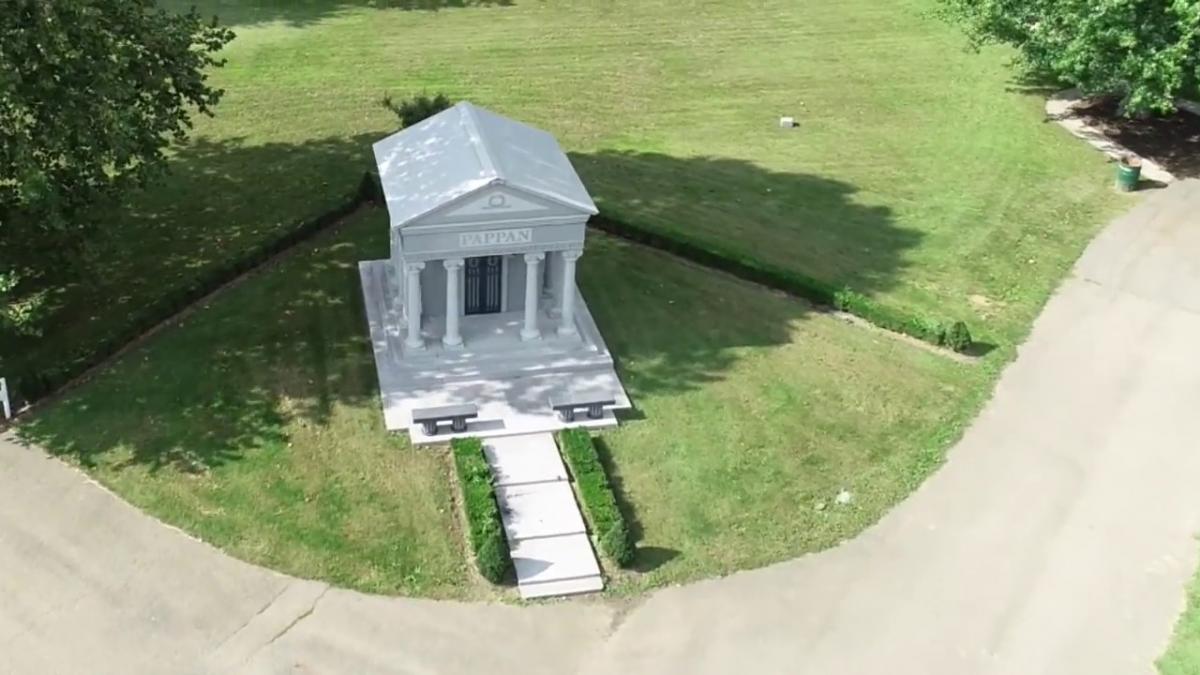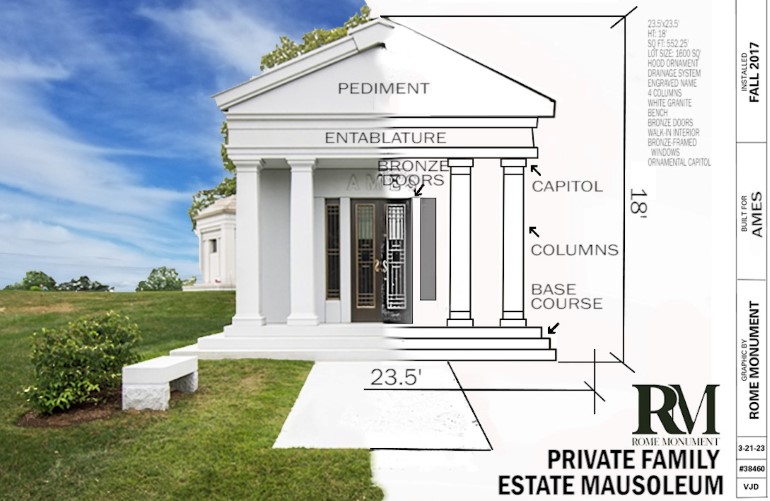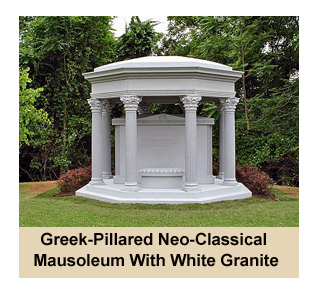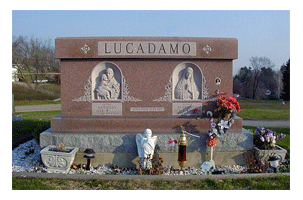How People Commission the Design and Construction of a Mausoleum In The United States
2023 US prices for custom 1 crypt mausoleums sold by Rome Monument start at $15K, 2 crypt mausoleums at $23K, 3 crypt mausoleums at $30K, 4 crypt mausoleums at $38K, 6 crypt family mausoleums at $45K, 8 crypt private mausoleums at $55K and walk-in family mausoleums at $85K.
- Three gates lead into the crypt of the Cascade Mausoleum at Bellefontaine Cemetery in St. Louis.
- The recently completed $5.3 million structure expertly incorporates historic and artistic elements into the tomb.
- The 26-foot-tall mausoleum was constructed using textured white and polished black granite.
- Visitors are invited to sit down, climb a staircase for the view, or admire stained-glass windows.
- At sunset, the three stained glass windows that line the side of the crypt are illuminated, shining their colored light into the crypt.
- Designed by Emil Frei & Associates, the stained glass windows are depictions of a dark-complected Jesus Christ.
- Thomas Wall of MWAD, based the private family mausoleum design on the client’s strong faith.
- The Cascade Mausoleum represents some of the most meaningful work the Mitchell Wall Architecture & Design company has produced.
- The Cascade Mausoleum was recognized by the 2022 Architecture Awards.
Get tips on selecting a U.S.-based mausoleum designer and builder and learn how to hire a mausoleum construction firm in the video below.
Watch The Video Below Titled "High Quality Mausoleum Design and Construction Overview"
Download Our High Quality Family Mausoleum Design And Construction Catalog
Browse pictures of 1 crypt mausoleums, above ground burial vaults, 2 crypt mausoleums, private family mausoleums for sale and stately walk-in mausoleums in this PDF guide. Learn how Rome Monument designs, builds and installs elegant mausoleums using high quality granite, impeccable construction standards and old world craftsmanship. Get an understanding of the customization and ordering processes. Learn about high-grade granite, mausoleum foundations, base courses, architectural options and landscaping considerations. Rome Monument is one of the leaders in the cemetery monument and memorial industry.
Watch The Video Below Titled "How To Purchase A Private Family Mausoleum"
- Rome Monument builds and installs private family mausoleums in cemeteries and on private property throughout the United States.
- Types of mausoleums include 1 crypt, 2 crypt, family mausoleums and walk-in mausoleums.
- If you are interested in ordering a custom designed mausoleum for yourself, you and your spouse, your parents, your children or other family members, please consider talking with Vince Dioguardi, the president of Rome Monument at 724-770-0100.
- Vince loves to talk about mausoleums and is very friendly, knowledgable and professional.
- During your phone conversation, he will be happy to explain how the process of ordering works, review how prices are determined, present your design customization options, touch on our mausolem construction standards and clarify mausoleum setting and installation details.
- If you prefer email to a phone conversation, please feel free to email Vince at info@romemonuments.com or contact him by using our Contact Form. Rome Monument also sells community mausoleums, private columbariums, church and community columbariums, crypts, urns and niche nameplates and plaques.
To learn how granite mausoleums are designed and built in the United States with custom sculptures, statues and columns, watch the video above.
About Rome Monument
- Founded in 1934, Rome Monument is a mausoleum construction company that custom designs and builds the highest quality private family mausoleums and columbariums in the United States.
- With manufacturing facilities in Pittsburgh, Pennsylvania, we transport and install mausoleums primarily throughout the United States.
- Watch a video to learn how to purchase a private family mausoleum.
- Watch how the Rome Monument team of foremen, field workers and project managers use heavy duty mausoleum construction equipment and a large crane to install a 2 person private family mausoleum in a cemetery. in the video below.
- If you want to know how Rome Monument designs and constructs high quality family mausoleums, watch the video titled "High Quality Mausoleum Design and Construction Overview".
- In this video, Rome Monument shows you how to tell the difference between high quality mausoleum and low quality mausoleum design and construction.
- Learn about the types of private family mausoleums along with the prices and costs for 1 crypt (single crypt) mausoleums, 2 person mausoleums, 3 crypt mausoleums and walk-in mausoleums in the video below.
In addition to a superior, professional design, the quality of a mausoleum depends on such factors as the reputation of the granite quarry, the quality of the granite, foundation, base course, side walls, roof and joints, among other construction elements.
Learn how ashes are buried in granite mausoleums and columbaria in the video guide to above ground interment and cremation niches.
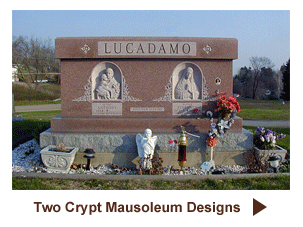 When people want to buy a high quality mausoleum, they call Rome Monument at 724-770-0100 to speak with Vince Dioguardi about the purchase, design and installation process. One way to determine the best mausoleum provider is to review their work.
When people want to buy a high quality mausoleum, they call Rome Monument at 724-770-0100 to speak with Vince Dioguardi about the purchase, design and installation process. One way to determine the best mausoleum provider is to review their work.Learn how private family mausoleums are designed and built with custom granite etchings and engravings in this video.
Find out why and how families are buried in private mausoleums, here.
- Call us at 724-770-0100
- Schedule a Showroom Visit
- Email us at info@romemonuments.com
- Browse Our Custom Mausoleum Designs
- Request a Price Estimate
- Ask a Question or Contact a Designer
Why People Commission the Design and Construction of Mausoleums
Mausoleums are not built only for the wealthy, prestigious, and self-important people of the world. They are built for every class, race, religion, social status, and job description. They are the interment option of choice for many, many reasons - practical, pompous and caring.
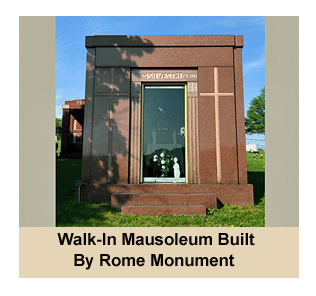 Chapel or walk-in mausoleums are buildings that allow people to be more comfortable and be protected from the rain and snow and cold weather while visiting a loved one. Families can visit any time of year, in any weather, even on a rainy Labor Day weekend or a snowy Christmas day. Pictured to the right is a walk-in family mausoleum designed and built by Rome Monument for a Catholic family. These types of mausoleums are for sale with prices starting at $85,000 for 2 to 4 crypts. Walk-in mausoleums with 6-8 crypts start at $145K. Crypts are located in the interior of the free standing mausoleum. The mausoleum pictured here was sold to the Silvestri family and installed in the Mt. Olivet Catholic Cemetery. The solid mausoleum was constructed with high quality granite. It includes a glass door and a small vestibule (foyer). The name of the family, Silvestri, was carved into the granite above the door. A tall Catholic style cross was carved by the Rome artisans into the outer walls on each side of the doorway. The two granite steps in front of the doorway were also designed and built by Rome Monument.
Chapel or walk-in mausoleums are buildings that allow people to be more comfortable and be protected from the rain and snow and cold weather while visiting a loved one. Families can visit any time of year, in any weather, even on a rainy Labor Day weekend or a snowy Christmas day. Pictured to the right is a walk-in family mausoleum designed and built by Rome Monument for a Catholic family. These types of mausoleums are for sale with prices starting at $85,000 for 2 to 4 crypts. Walk-in mausoleums with 6-8 crypts start at $145K. Crypts are located in the interior of the free standing mausoleum. The mausoleum pictured here was sold to the Silvestri family and installed in the Mt. Olivet Catholic Cemetery. The solid mausoleum was constructed with high quality granite. It includes a glass door and a small vestibule (foyer). The name of the family, Silvestri, was carved into the granite above the door. A tall Catholic style cross was carved by the Rome artisans into the outer walls on each side of the doorway. The two granite steps in front of the doorway were also designed and built by Rome Monument. Cemeteries such as Cleveland's Lakeview Cemetery, founded in 1869, offer numerous above ground options for mausoleums. One of the most famous above-ground structures located in "Cleveland's Outdoor Museum" is the James A. Garfield Memorial. Mausoleum entombment provides a very dry and clean type of burial and minimizes the problems caused by ground burials. Side-by-side two crypt mausoleums are often purchased by married couples in advance of their eventual interment. Rome Monument designed and constructed one of these types of mausoleums for Walter R. Kasper and Margaret Kasper of Ambridge, PA. It is a fitting memorial for a fantastic couple.
- Call us at 724-770-0100
- Schedule a Showroom Visit
- Email us at info@romemonuments.com
- Browse Our Custom Mausoleum Designs
- Request a Price Estimate
- Ask a Question or Contact a Designer
Choosing The Type Of Mausoleum You Want
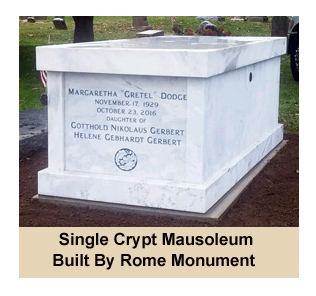 While we most often think of mausoleums as elaborate buildings erected for rich or prestigious people, they are, in fact, often simple stone encasements that surround the coffin and that are not much bigger than the coffin. Think of a butter dish that covers a stick of butter. The simplest mausoleums are single crypt mausoleums that hold just one casket. The crypt is approximately 2½-feet square and 8-feet long. The opening into which the casket is placed is covered with a “shutter”, a marble, granite or bronze front that can be highly decorative. A single crypt can be a mausoleum in and of itself, called a lawn crypt, or be placed in a larger mausoleum building. Prices for single crypt mausoleums, also referred to as 1 crypt mausoleums, start at $15,000. Pictured to the right is a single crypt mausoleum designed and built by Rome Monument. It was made with marble and set in Lancaster Cemetery in Lancaster, PA on November 2, 2016. It was built to
While we most often think of mausoleums as elaborate buildings erected for rich or prestigious people, they are, in fact, often simple stone encasements that surround the coffin and that are not much bigger than the coffin. Think of a butter dish that covers a stick of butter. The simplest mausoleums are single crypt mausoleums that hold just one casket. The crypt is approximately 2½-feet square and 8-feet long. The opening into which the casket is placed is covered with a “shutter”, a marble, granite or bronze front that can be highly decorative. A single crypt can be a mausoleum in and of itself, called a lawn crypt, or be placed in a larger mausoleum building. Prices for single crypt mausoleums, also referred to as 1 crypt mausoleums, start at $15,000. Pictured to the right is a single crypt mausoleum designed and built by Rome Monument. It was made with marble and set in Lancaster Cemetery in Lancaster, PA on November 2, 2016. It was built to 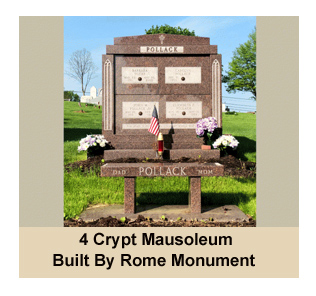 memorialize Margaretha "Gretel" Dodge.
memorialize Margaretha "Gretel" Dodge.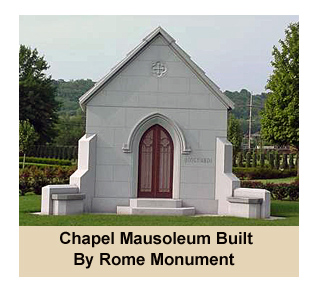 Pictured to the right is a chapel style walk-in private family estate mausoleum. Chapel style walk-in mausoleum prices start at $180K. This 9-crypt chapel mausoleum was designed by Vince Dioguardi, the Rome Monument owner and president. 9 crypt family mausoleums without vestibules and doors are sold by Rome Monument with prices starting at $60K. The chapel mausoleum pictured to the right was constructed by Rome Monument craftsman and was built for the Dioguardi family using Rock of Ages granite. Granite is the most popular building material for exteriors for private family chapel mausoleums due to its strength, hardness and longevity. The roomy interior visiting space of the chapel mausoleum pictured here makes excellent use of ornate carvings, decorations, ornamentation and marble. An altar was placed in the center of the interior of this chapel mausoleum. The interior visiting space is used by the Dioguardi family for prayer, communion, reflection and worship. Multiple generations of the Dioguardi family are assured a space in this private family chapel style walk-in mausoleum.
Pictured to the right is a chapel style walk-in private family estate mausoleum. Chapel style walk-in mausoleum prices start at $180K. This 9-crypt chapel mausoleum was designed by Vince Dioguardi, the Rome Monument owner and president. 9 crypt family mausoleums without vestibules and doors are sold by Rome Monument with prices starting at $60K. The chapel mausoleum pictured to the right was constructed by Rome Monument craftsman and was built for the Dioguardi family using Rock of Ages granite. Granite is the most popular building material for exteriors for private family chapel mausoleums due to its strength, hardness and longevity. The roomy interior visiting space of the chapel mausoleum pictured here makes excellent use of ornate carvings, decorations, ornamentation and marble. An altar was placed in the center of the interior of this chapel mausoleum. The interior visiting space is used by the Dioguardi family for prayer, communion, reflection and worship. Multiple generations of the Dioguardi family are assured a space in this private family chapel style walk-in mausoleum.Architectural Styles of Mausoleums
- Call us at 724-770-0100 to Discuss the Design and Construction of a Family Mausoleum
- Schedule a Showroom Visit to Speak With A Mausoleum Desgner
- Email us to Request Mausoleum Information at info@romemonuments.com
- Browse Our Custom Private Family Mausoleum Designs
- Request a Price Estimate For the Design and Construction of a Mausoleum
- Ask a Question or Contact a Mausoleum Designer
How Rome Designs Mausoleums
- Call us at 724-770-0100 to Discuss the Design and Construction of a Family Mausoleum
- Schedule a Showroom Visit to Speak With A Mausoleum Desgner
- Email us to Request Mausoleum Information at info@romemonuments.com
- Browse Our Custom Private Family Mausoleum Designs
- Request a Price Estimate For the Design and Construction of a Mausoleum
- Ask a Question or Contact a Mausoleum Designer
During our initial consultation, we will discuss your wants and needs, discuss mausoleum design options, discuss your cemetery preference and its rules and regulations concerning mausoleums, show you the costs of various mausoleum designs, find out the number of family members that will be entombed in the mausoleum now and in the future, and work out some initial designs with you. Decisions need to be made regarding the style of the monument. Some of the more popular mausoleum architectural style include:
- Mausoleums with Classical Style Architectural Design
- Mausoleums with Neoclassical Style Architectural Design
- Mausoleums with Baroque Style Architectural Design
- Mausoleums with Romanesque Style Architectural Design
- Mausoleums with Asian Style Architectural Design
- Mausoleums with Egyptian Style Architectural Design
- Mausoleums with Islamic Style Architectural Design
- Mausoleums with Contemporary or Modern Architectural Design
- Mausoleums with Islamic Architecture Design
- Statues
- Sculptures
- Bas Reliefs
- Friezes
- Murals
- Photographs
- Vases
- Lamps
- Furniture
- Stained Glass Windows
- Chapel Items
- Cross
- Personal Artifacts
- Books
- Funerary Art and more
How Rome Builds Mausoleums
Once the mausoleum design and cost are approved, we assemble the team that will make your mausoleum design a reality, including trusted architectural design and construction professionals. Then the mausoleum is delivered to the cemetery and assembled at the site. However, the construction process is still not completed. If the design calls for it, plumbing and electricity needs to be set up.
a design/builder of private family mausoleums for cemeteries and memorial parks.
We design, build and install single crypt mausoleums, two crypt mausoleums, private estate mausoleums, family mausoleums, chapel mausoleums and garden mausoleums for families throughout the United States.
Watch Rome Monument Build A Private Family Mausoleum On YouTube
In this video on YouTube, Rome Monument takes you through the steps on how a mausoleum is designed and built. It follows the construction of a Greek Neoclassical-style mausoleum for the Pappan family of Pennsylvania that was installed in Beaver Cemetery, Beaver Pennsylvania in 2015. Rome Monument is a mausoleum construction company, mausoleum contractor and mausoleum builder with over 80 years of experience as a design/builder of private family mausoleums for cemeteries and memorial parks.
Mausoleum Design Plans and Construction Contracts
We draft mausoleum design plans using CAD software and present these drawings and renderings to our clients for approval before beginning construction. Click here to see a preliminary family mausoleum construction design plan made using a CAD program.
The mausoleum construction drawings we produce and submit to our clients include precise dimensioned architectural plans, structural plans, electrical plans and mechanical specifications. We present out customers with construction contracts that define how much it will cost to build their mausoleum.
Click here to view pictures of mausoleums designed and built by Rome Monument.
Mausoleum Construction Standards
Our rigorous and meticulous mausoleum construction standards ensure the following safeguards and customer service requirements.
- Safe and permanent
- Quality construction, craftsmanship and reliability
- Engineering excellence
- Thorough site condition acceptability
- Competent architectural design and structural analysis
- First-rate granite and marble installation
- Design and construction for seismic load protection
- Solid concrete foundations
- Resistant to hurricanes and storm damage
- Resistant to fire and use incombustible materials
- Plumbing work complies with provisions of the Uniform Plumbing Code
- Properly ventilated mausoleums and crypts
- Electrical work complies with the provisions of the National Electrical Code
- Adequate drainage
- Permanently secure and protected doors, windows, walls and crypts
- Proper selection of building materials
- Compliance with existing zone laws
- Prevention of 'mausoleum odors' created by decomposing human remains
- Adequate crypt foundation plans
- Top-end mausoleum niche manufacturing and installation
- On-time and on-budget
- Surpassing performance requirements
- Qualified field supervision and management
- Timely delivery and installation of mausoleums
- Professional installation methodologies
- Quality control
- Adequate warranties
- Permitting process, inspection and third party vendor compliance
- Post construction support
- Reliable mausoleum cleaning, maintenance and restoration services
How Mausoleum Prices are Determined
- Call us at 724-770-0100 to Discuss the Design and Construction of a Family Mausoleum
- Schedule a Showroom Visit to Speak With A Mausoleum Desgner
- Email us to Request Mausoleum Information at info@romemonuments.com
- Browse Our Custom Private Family Mausoleum Designs
- Request a Price Estimate For the Design and Construction of a Mausoleum
- Ask a Question or Contact a Mausoleum Designer
Factors that determine price include:
- Style
- Details of crypt – art, etchings, engravings, photographs, etc.
- Quality of the granite
- Detail and materials, usually bronze or granite, of shutter (door on the opening of the crypt)
- Style
- Details of crypts – art, etchings, engravings, photographs, etc.
- Quality of the granite
- Detail and materials, usually bronze or granite, of shutter
- Number of Crypts
- Architectural Style
- Size
- Details of crypts and mausloseum– art, etchings, engravings, photographs, etc.
- Quality of the granite
- Accessories
- Funerary Art
- Number and Types of Rooms
- Electricity and Plumbing
Some factors that determine price:
- Number of Crypts
- Architectural Style
- Size
- Details of crypts and mausoleum– art, etchings, engravings, photographs, etc.
- Quality of the granite
- Accessories
- Funerary Art
- Number and Types of Rooms
- Electricity and Plumbing
- Casket – $1,095 to $8,995
- Crypt Liner – $675
- Opening and closing – $1,245 to $2,745
- Engraving on crypt front – $455 to $575
Famous Mausoleums
Watch a video produced by Rome Monument titled "See Inside Large Mausoleums Built for Famous Americans". This video showcases large fancy mausoleums designed and built as monuments for the entombment of famous Americans. The video features the Lincoln Tomb, Grant's Tomb, William McKinley Tomb, the Royal Mausoleum of Hawaii, Will Rogers Shrine of the Sun and the Lillian Russell Moore Mausoleum. Find out how these famous tombs and interment spaces were designed and constructed, how much it cost to build these historic mausoleums, and what it costs to build a beautiful private family mausoleum in 2018. A very interesting article about famous mausoleums was written by Douglas Martin for the New York Times is titled "Deathstyles of the Rich and Famous".
Throughout history, mausoleums have served an important role in cultures throughout the world. Following are some of the more prominent mausoleums.
The Guri Amir is a mausoleum of the 14th century Asian conqueror Timur (Tamerlane). Located in Uzbekistan, it is important because its Persian-Mongolian architecture was a model for later Mughal architecture tombs, including the Taj Mahal. The eight-sided building is crowned by a dome which contains the tombs of Tamerlane, his sons, grandsons, and Timur’s teacher. The entrance portal is richly decorated with carved bricks and various mosaics. The inside the mausoleum is a large, high chamber with deep niches, paintings, and high-relief papier-mache cartouches. Much of the structure has been destroyed and what remains has been heavily restored.
On April 15, 1865, the day President Lincoln died, a group of Springfield citizens started a successful drive to collect funds to construct a memorial or tomb for “Honest Abe”. Its main feature is an obelisk which rises over one hundred feet. [http://www.lincolntomb.org/tomb.htm]. Inside, a rotunda and corridors contain versions of important Lincoln statues, as well as plaques with excerpts from Lincoln’s famous speeches. There are four bronze sculpture groups, each representing one of the four Civil War military services. The bodies of Lincoln, his wife and three youngest of his sons are placed in crypts in the mausoleum.
Grant's Tomb honors the life of Civil War General and 18th President of the United States Ulysses S. Grant. It was commissioned in 1885 by the Mayor of New York following Grant’s death in 1877. An open competition was held for the mausoleum’s design, which was won by John Hemenway Duncan. Duncan’s objective was "to produce a monumental structure that should be unmistakably a tomb of military character…and the epitome of reverence and respect”. Needless to say, he succeeded in his vision. The tomb's granite exterior is modeled after the Mausoleum of Halicarnassus with Persian elements. The twin sarcophagi of Grant and his wife Julia are similar to the sarcophagus of Napoleon Bonaparte at Les Invalides. Mosaics with scenes of Grant’s famous Civil War victories are found within the tomb. Located in Upper Manhattan, New York City, Grant’s Tomb is the second largest mausoleum in North America.
Queen Victoria, long-reigning Queen of the United Kingdom who died in 1901, is entombed in the Royal Mausoleum on the grounds of Windsor Castle in Berkshire, England. The exterior of the mausoleum is inspired by Italian Romanesque buildings and is shaped like a Greek cross. The monumental tomb features recumbent marble effigies of the Queen and her husband, Prince Albert. The building was finished 1862.
Mausoleums and Tombs
A tumulus is a mound of earth and stones raised over a grave or graves. In the Americas, Indian burial mounds are type of tumuli. Indian burial mounds date back to at least 3400 BC. The largest mound site in the United States is Cahokia Mounds located near St. Louis, Missouri. Tumuli are common throughout the world and are also known as barrows, burial mounds, Hügelgräber or kurgans'.
A sepulchre is a cavernous rock-cut space for interment, generally associated with the Jewish or Christian faiths. Well-known sepulchers in the Holy Land include the Tomb of Jesus in the Church of the Holy Sepulchre.
Megalithic tombs are above ground prehistoric burial chambers, built of large stone slabs laid on edge and covered with earth or other smaller stones. They are a type of chamber tomb, and were built across Europe, the Mediterranean, and neighboring regions mostly during the Neolithic period.
Hypogeum tombs are stone-built underground structures for interment, such as the tombs of ancient Egypt, and date back to 3600 BC. Christians built similar structures which they called catacombs. Hypogea often have niches for cremated human remains or loculi for buried remains. The Northern and Southern Mazghuna pyramids, and the Southern South Saqqara pyramid are examples of Egyptian hypogea.
A kokh tomb complex is a series of long narrow shafts, in which the deceased were placed for burial, radiating from a central chamber. These tomb complexes were generally carved into a rock face, and were usually closed with a stone slab. A kokh tomb complexes can be found at the far west end of the Church of the Holy Sepulchre in Jerusalem and throughout the Judean foothills.
A pillar tomb is a monumental grave with a single, prominent stone pillar or column as its central feature. Many world cultures incorporated pillars into their tomb designs. Examples of pillar tombs are the Harpy Tomb of Xanthos in the ancient Greek colony of Lycia in Anatolia, and the tombs at Malindi and Mnarani, built by the medieval Muslim Swahili culture of the Swahili Coast.
A rock-cut tomb is a burial chamber that is cut into an existing, naturally occurring rock formation, usually along the side of a hill. It was a common form of burial for the wealthy in ancient times in several parts of the world. Important examples are found in Egypt between the Valley of the Kings and the Valley of the Queens, and in southern Jordan, most significantly the city of Petra. Its towering, intricate rock-cut architecture has earned the designation of one of the “New Seven Wonders of the World”.
Cist tombs are small stone coffin-like boxes or ossuaries used to hold the bodies of the dead. This type of tomb was used from Prehistoric times to the Middle Ages in Europe and Asia. The grave can be lined with stones and covered with stone slabs, or enclosed on all four sides by stone slabs and covered with a lid.
A sarcophagus is a stone-carved box-like container for a body or coffin, often decorated with art, inscriptions and carvings, sometimes part of a monument, and most often displayed above ground. It can stand within a religious building or greater tomb or mausoleum, though it can also be buried. First used in Ancient Egypt and Ancient Greece, its popularity spread throughout the ancient world. These cultures revered their dead, preserving the mummified body in the sarcophagus and including items of value for them in the afterlife. It was often used in later years of European society by high status members of the clergy, government, or aristocracy. An example of an ancient sarcophagus is ancient Egypt’s pharaoh Tutankhamun. The sarcophagus was used primarily to protect the wood coffins that were placed inside it as well to protect the mummified body from the elements.
Catacombs are ancient, human-made subterranean cemeteries that contain individual tombs (usually sarcophagi). Any chamber used as a burial place is a catacomb, although the word is most commonly associated with the Roman Empire. Their catacombs date back to the 2nd century AD, and a well-known example is the Catacombs of Rome.
Burial crypts are stone or brick-lined underground spaces for interment, usually vaulted and beneath a religious building such as a church, usually for groups of people, either general public or private families. They may contain church monuments, sarcophagi or coffins. More recently, the term crypt has come to mean a stone chambered burial vault used to store the deceased. Crypts are usually found in cemeteries and under public religious buildings, such as churches or cathedrals, and beneath mausolea or chapels on personal estates. Wealthy or prestigious families will often have a 'family crypt' or 'vault' in which all members of the family are interred. In some regions, an above ground crypt is commonly called a mausoleum, which also refers to any elaborate building intended as a burial place, for one or any number of people.
How to Get Started on Designing Your Mausoleum
- Call us at 724-770-0100 to Discuss the Design and Construction of a Family Mausoleum
- Schedule a Showroom Visit to Speak With A Mausoleum Desgner
- Email us to Request Mausoleum Information at info@romemonuments.com
- Browse Our Custom Private Family Mausoleum Designs
- Request a Price Estimate For the Design and Construction of a Mausoleum
- Ask a Question or Contact a Mausoleum Designer
Download Our High Quality Family Mausoleum Design And Construction Catalog
Browse pictures of 1 crypt mausoleums, 2 crypt mausoleums, private family mausoleums and stately walk-in mausoleums in this PDF guide. Learn how Rome Monument designs and builds elegant mausoleums using high quality granite, impeccable construction standards and old world craftsmanship. Get an understanding of the customization and ordering processes. Learn about high-grade granite, mausoleum foundations, base courses, architectural options and landscaping considerations.
Rome Monument Expands Installation Area Across U.S.
Posted on February 26, 2019
In January of 2019, Rome Monument, a mausoleum design and construction company based in Pittsburgh, purchased two new custom monument trucks. The private family mausoleum builder now has the manpower and equipment to deliver and install high quality single crypt, two crypt, walk-in family mausoleums and multi-crypt above ground burial vaults in all 48 states. Both of the new mausoleum installation trucks purchased by Rome Monument use truck-mounted articulating cranes to set and install granite mausoleum foundations, walls, roofs, doors, crypts and heavy stones. Rome Monument is currently very busy manufacturing and building mausoleums purchased by private customers in large cities and wealthy communities all across the continental United States. Private family mausoleum prices start at $15K. Some of the new mausoleum installation areas in the United States are listed below.
- Walk-In Mausoleums For San Francisco California Families
- Above Ground Burial Vaults For Kentucky Families
- Private Mausoleums For Miami Families
- Above-Ground Entombment Options For Tampa Florida Families
- Mausoleums For Sale For Greenville North Carolina Families
- Cemetery Mausoleums For Pittsburgh Families
- Mausoleum Crypts For New York City Families
- Private Walk In Mausoleums Constructed For Boston Massachussets Families
- Family Crypts and Private Mausoleums Sold To Chicago Illinois Families
- Unique Private Family Mausoleums For Connecticut Families
- Indoor Entombment For Philadelphia Pennsylvania Families
- Above Ground Interment Options For Fairfield County Virginia Families
- Stately Mausoleum Structures For Washington DC Families
- Private Estate Mausoleums, Private Family Tombs And Indoor Chapel Mausoleums For Maryland Families
- Personal Family Mausoleums For Sale To Fairfax County Virginia Families
- Private Family Mausoleum Options For New Jersey Families
- Private Estate and Luxury Mausoleums And Sarcophagi For Massachusetts Families
- Private Family Estate Mausoleums And Mausoleum Buildings For Columbus Ohio Families, Cemeteries And Churches
- Private Family Estate Mausoleums And 2 Crypt Mausoleums For Williamson County Tennessee Families
- Private Family Mausoleums For Westchester County New York Families, Cemeteries And Churches




